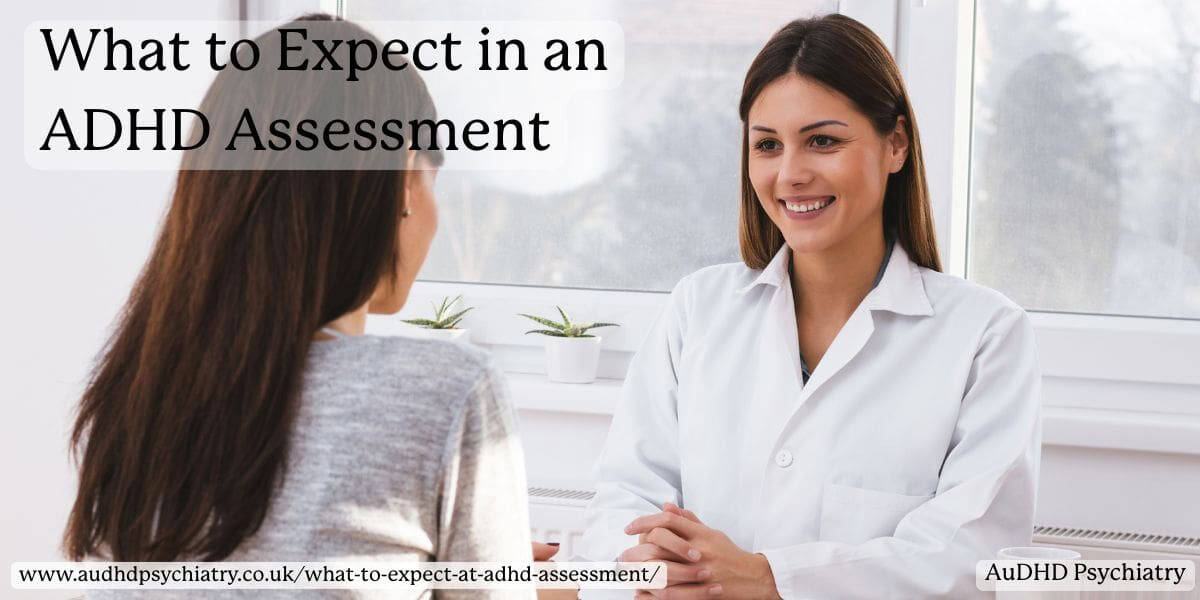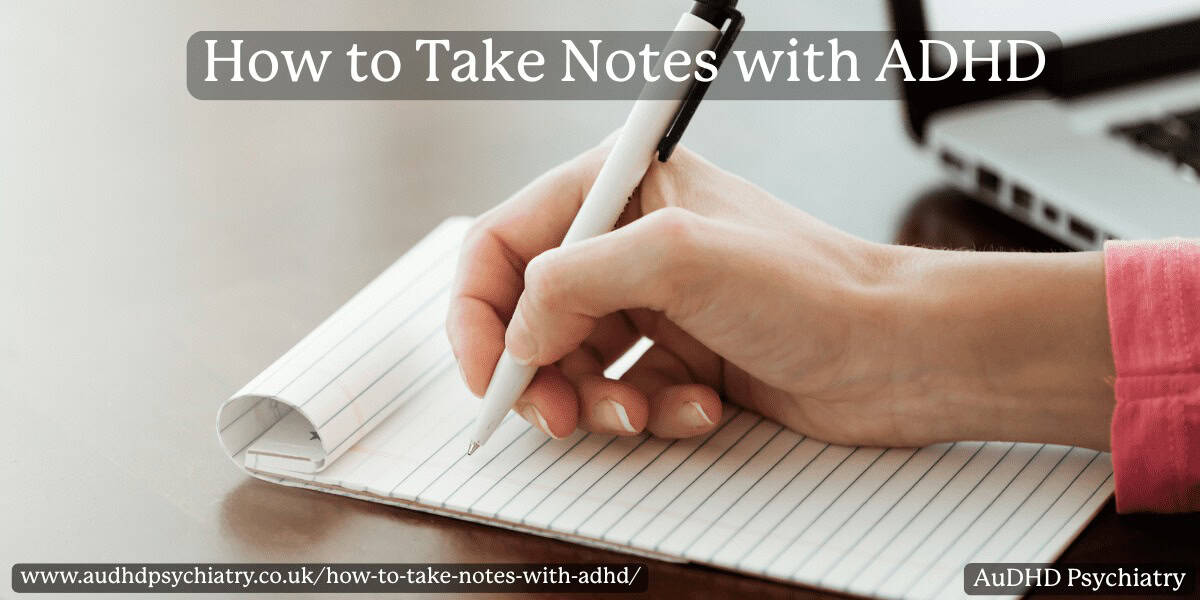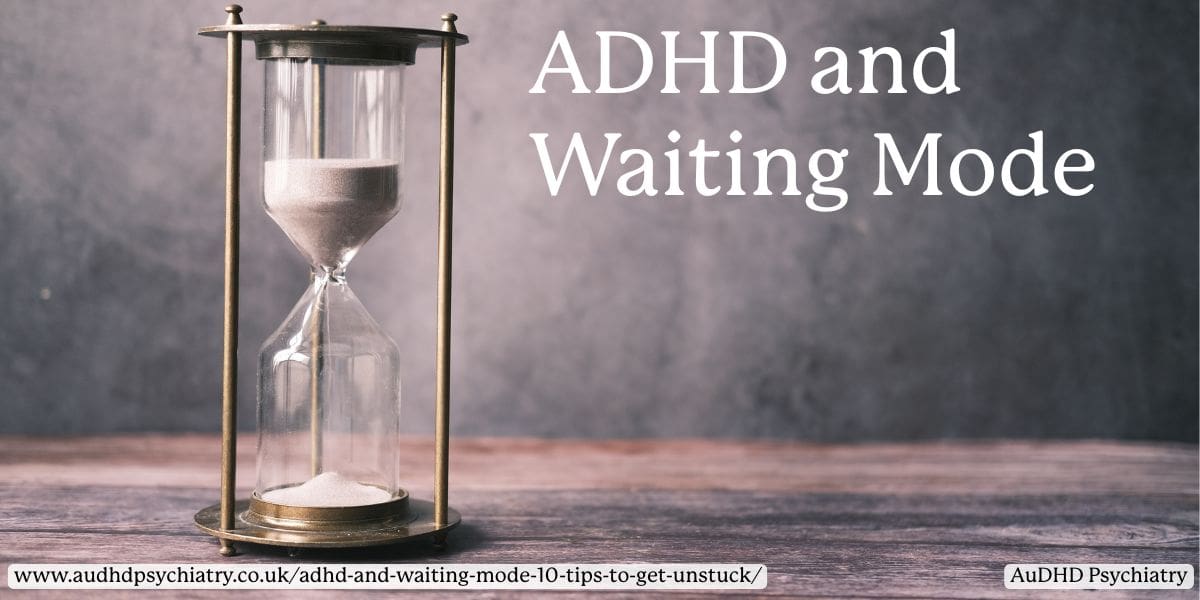
That feeling of complete paralysis before a big event, where you can’t focus on even the simplest tasks – sounds familiar? This challenge, known as ADHD waiting mode, affects many people’s lives and makes time management seem impossible before scheduled commitments. It’s a prime example of how ADHD can leave you feeling trapped and unproductive.
ADHD waiting mode creates a perfect storm by combining executive dysfunction, anxiety, and time blindness. Your brain’s attention system freezes up, especially when you have upcoming events on your mind. This state of ADHD paralysis means you’re stuck doing nothing, even when you have important tasks to complete.
People with ADHD process dopamine differently from others, which impacts their motivation and makes it tough to focus on tasks that don’t give quick rewards.
Perhaps you’re here because you’re curious why this waiting mode happens and how time agnosia shapes our perception during these waiting periods. In this guide, we’ll explore how to overcome ADHD waiting mode with practical, research-backed tips, addressing the time anxiety ADHD often brings.
This might help if you struggle with productivity before appointments, which some may refer to as time paralysis, or are caught in an anxious holding pattern. Understanding and managing this common ADHD experience becomes easier with the right strategies, helping you overcome the feeling that you can’t do anything when waiting mode strikes. (And if you’re seeking an Edinburgh ADHD clinic that can help, don’t forget to book a call!).
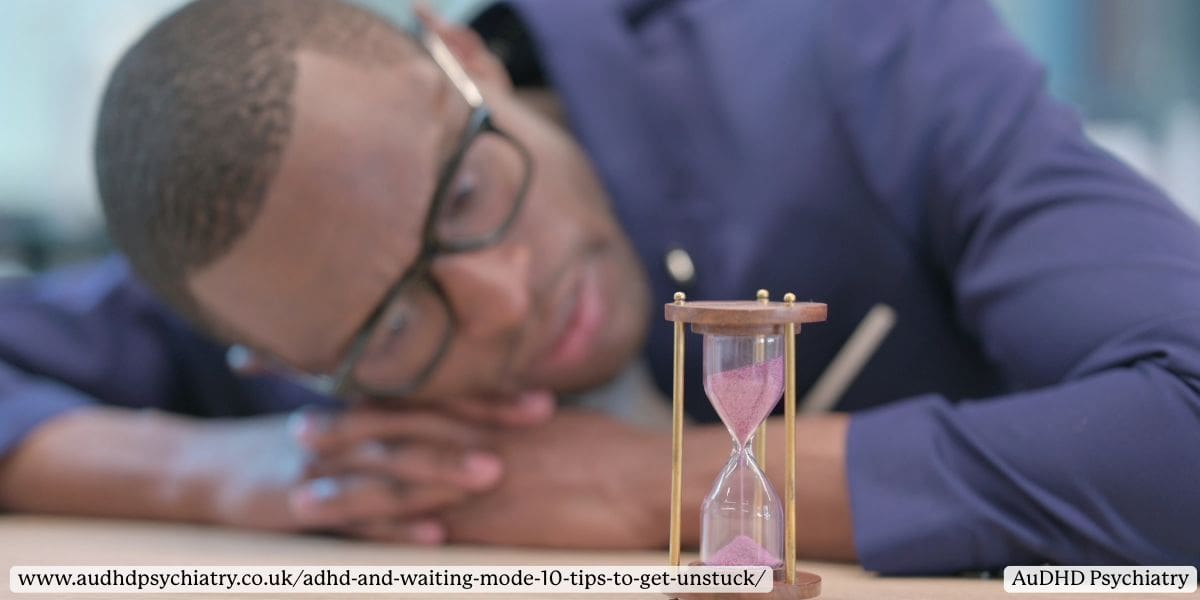
Understanding ADHD Waiting Mode: Why It Happens and How to Cope
First, let’s discuss waiting mode psychology. What is the correlation between ADHD and waiting? Simply put, the ADHD brain works differently when it comes to waiting. This difference comes from how it processes dopamine and neural activity.
People with ADHD wait mode often describe feeling ‘frozen’ between knowing and doing. Research shows decreased grey matter volume in significant brain regions, including the thalamus and anterior cingulate cortex. These changes affect mood regulation and executive functions, contributing to the challenges of waiting anxiety and task paralysis.
The ADHD Brain and Waiting Mode: Executive dysfunction 101
Waiting mode shows up as a complex mix of brain structure and function. Scientists found that ADHD brains don’t reduce very low-frequency oscillations as much during waiting periods. This change in neural activity affects focus and productivity while waiting, often leading to a state where you feel stuck doing nothing.
The brain’s frontostriatal networks control reward processing and related cognitive functions. These networks show consistent differences in ADHD. Such structural changes help explain why those with ADHD can’t focus during delays, making it hard to manage time, and contributing to the experience of ADHD impatience.
How the ADHD brain processes anticipation
People with ADHD process anticipation differently in their ventral striatum, a vital part of the reward system. Research shows their brains respond more strongly when anticipating and receiving rewards. This sensitivity makes waiting feel more intense and overwhelming, often triggering anticipation stress.
Time agnosia changes how the brain notices time passing. A few minutes might feel like hours, while hours can seem like minutes. This warped sense of time pairs with executive dysfunction, creating significant time estimation challenges.
The result? Starting tasks gets harder as the brain fixates on what’s coming up, leading to task inertia.
The link between waiting mode and anxiety
The ADHD brain creates a complex connection between anxiety and waiting mode. Studies show mood regulation problems are common in ADHD patients. This emotional dysregulation starts a cycle.
Another question that may arise is, “Does waiting mode affect productivity and daily life?” The simple answer is yes, and it’s because anxiety about waiting reduces productivity, which leads to more anxiety and emotional fluctuations.
Waiting mode can significantly impact productivity and daily routines. It often leads to increased stress, wasted time, and difficulties in managing work and social commitments. However, understanding this phenomenon can help individuals develop strategies to use waiting time more effectively, addressing issues like task inertia and scheduling challenges.
Tools to Reduce Waiting Anxiety in ADHD
You can handle waiting better by using alarms and creating brain dumps. These tools help manage overwhelming thoughts and lower anxiety. Setting alarms works as a backup system to combat time blindness. Brain dumps let you release mental pressure by writing down preparation steps, helping to reduce rumination and overwhelm.
Science tells us that children with ADHD show more waiting impulsivity and less inhibitory control. They tend to stop waiting once they start. This suggests the struggle isn’t just about wanting instant rewards – it’s about the brain’s basic ability to stay focused while waiting, highlighting the need for effective distraction techniques.
Why ADHD Waiting Paralysis Needs Targeted Strategies
Knowing these brain differences helps explain why “ADHD waiting paralysis” happens. The brain processes rewards differently and has structural changes in key areas. This creates unique challenges that need specific solutions.
Understanding these biological factors, including dopamine seeking behavior and issues with attention regulation, helps develop coping strategies that work with the ADHD brain’s natural patterns.
The Science of Time Perception in ADHD
The brain’s ability to process and understand time shapes our daily experiences. Research shows the ADHD brain processes temporal information quite differently, which affects everything from managing tasks to dealing with wait times.
Understanding time blindness and time agnosia
The scalar expectancy theory (SET) describes how typical brains measure time using an internal clock system. This system counts heartbeats and uses environmental cues like brightness and temperature. People with ADHD process time differently, which leads to time blindness and problems with temporal processing, often resulting in severe time anxiety ADHD symptoms.
Children with ADHD show much higher discrepancy scores on time reproduction tasks. These differences don’t come from intellectual disabilities or working memory issues. The root cause lies in changes to brain regions that handle temporal processing, affecting cognitive connectivity.
People with ADHD excel at detecting and interpreting emotional time-related tasks, performing better than control groups. Yet they find it hard to estimate neutral time intervals, often getting them way off the mark, which contributes to scheduling challenges.

Why waiting feels different with ADHD
Complex neural mechanisms control how the brain handles waiting and time perception. Children with ADHD tend to give up on waiting, particularly during long periods. This behaviour goes beyond just wanting instant rewards—it reflects basic differences in how the ADHD brain processes anticipation and time, often leading to ADHD impatience.
What Science Says About ADHD and Time Perception
Research points to several reasons why waiting feels different:
- Processing speed variations: Children with ADHD display clear differences in time discrimination and processing speed
- Emotional impact: The brain reacts more intensely to emotional stimuli during waiting periods, triggering anxiety triggers
- Cerebellar differences: Increased grey matter volume in the cerebellum changes time perception
Scientists discovered that money rewards and ADHD medications improved time perception similarly. This suggests a strong connection between dopamine levels and temporal processing. Music has also shown good results in reducing inattention symptoms during wait times, serving as an effective distraction technique.
How Waiting Mode Affects Productivity
The ADHD brain’s unique way of experiencing time affects focus and task completion. Children with ADHD find it hard to handle prospective memory time tasks. This makes remembering and planning future events challenging, contributing to transition difficulties. These differences in temporal processing continue into adulthood and affect many aspects of daily life.
The brain’s altered reward processing combines with different temporal perception to create a unique experience. This understanding of neurological differences explains why waiting feels more intense and challenging for people with ADHD, requiring specific management strategies to address waiting anxiety and productivity challenges.
How Waiting Mode Affects Daily Life
The brain creates an interesting paradox during waiting mode that affects daily functioning. Your brain’s focus on future events makes it hard to stay productive now. The ADHD brain really shines under pressure and produces amazing results at the last minute. This same trait can make it tough to handle everyday tasks, often leading to a feeling of being stuck doing nothing.
The productivity paradox
People who have ADHD often do brilliant work under pressure and pull off impressive results right before deadlines. The last-minute success takes its toll through messed up sleep patterns, higher stress levels, and chaotic daily routines. Time agnosia makes it tough to figure out how long tasks will take, which leads to missed deadlines and lost productivity, contributing to significant scheduling challenges.
Social and work impacts
Waiting mode doesn’t just hurt your productivity – it ripples through your work and social life. Many people get stuck between tasks and can’t focus on work while thinking about upcoming events. Your brain gets fixated on specific activities so much that other tasks become impossible, a state often described as task paralysis.
Working under pressure might work sometimes, but it comes with big risks:
- Higher stress and frustration
- Messed up sleep patterns
- Chaotic routines and priorities
- No time to check work quality
These factors contribute to the feeling of being trapped in a cycle of productivity challenges.

The emotional toll of being stuck
Waiting mode shows up through physical and psychological symptoms. Your brain shifts into a state where anxiety and restlessness take over, leading to:
- Physical symptoms like dizziness and stomach aches
- Muscle tension and racing heart
- Sweating and shortness of breath
Waiting periods often trigger intense emotions and sensory overload. The ADHD brain doesn’t deal very well with schedule control during unexpected delays, which sets off stress and impatience alarms. This emotional rollercoaster affects your focus and productivity. You might bounce from frustration to anger within minutes, experiencing significant emotional fluctuations.
The ongoing fight with time blindness makes every hour feel like two, especially when you’re stuck waiting. This warped time perception mixes with executive functioning challenges. Task-switching gets harder and harder, a phenomenon known as task inertia. Brain dumps and multiple alarms can help you manage overwhelming thoughts and reduce anxiety, providing effective ways to cope with waiting.
Breaking the Cycle with Brain-Based Strategies
Neuroplasticity shows how our brain can reorganise itself and provides promising strategies to manage the ADHD waiting mode. Research shows that cognitive training and behavioural therapies can help you control impulses better and improve your attention span, addressing issues like task paralysis and attention regulation.
Brain dump techniques that actually work
Brain dumps help clear your overwhelmed mind by moving information elsewhere. Start by writing down everything you’re thinking about—tasks, worries, random thoughts—without filtering. You can then organise these thoughts into colour-coded categories.
The final step is to identify, then remove items that don’t need action or are beyond your control. This technique is particularly effective for managing rumination and overwhelm.
Focus-shifting exercises
New environments help your cognitive function through planning and problem-solving. Balance exercises help connect your cerebellum to your prefrontal cortex and improve your executive function skills. Activities like martial arts, gymnastics, or mountain biking show the best results for concentration and focus, helping to overcome the feeling of being stuck doing nothing.
You can also learn more about the role of exercise in managing ADHD symptoms and how movement supports brain regulation.
Using hyperfocus to your advantage
Your ADHD brain handles task-switching differently, which affects your focus and waiting mode. Here’s how to use hyperfocus productively:
- Create well-laid-out work-break schedules (25 minutes of work with 5-minute breaks)
- Set timers when you need to switch tasks
- Schedule routine tasks at the same time daily
These strategies can help manage transition difficulties and improve overall productivity.
Research shows that cognitive interventions using neuroplasticity bring lasting benefits. These interventions adapt to your unique cognitive profile—people with memory issues benefit from specific training exercises, while those who struggle with impulse control can participate in targeted cognitive tasks.
Music and art are great ways to improve concentration, focus, and memory. Video games teach new skills through problem-solving and bouncing back from failure, which helps emotional control and can be an effective distraction technique.

Body doubling—having someone sit with you while you work—helps manage waiting time anxiety by reducing hyperactivity and keeping you motivated. Simple activities like doodling or using stress balls while you fidget can boost your focus and productivity, addressing issues of ADHD impatience and waiting anxiety.
Apps and technology built for the ADHD brain can help you stay motivated through in-game rewards. The key isn’t fighting these brain patterns but working with them to create strategies that match your natural tendencies, including your tendency for dopamine-seeking behaviour.
Breaking Free from ADHD Waiting Mode: Practical Strategies
Experiencing ADHD waiting paralysis does not mean you’re unmotivated. It’s a neurological response. In this section, we’ll share practical ways to cope when ADHD puts your life on pause.
These strategies are a lifeline if you have ADHD waiting mode. You can transform waiting from an anxiety source into something more manageable by applying specific techniques mindfully, addressing both time anxiety, ADHD and the feeling of being trapped.
The lifeblood of handling waiting mode lies in grace and acceptance. Your brain’s different functioning helps remove unhelpful labels like ‘lazy’. You can minimise time spent in waiting mode by scheduling appointments early in the morning and working with your natural rhythms to avoid task inertia.
The 2-minute Rule for ADHD
One practical method to consider is the 2-minute rule to build momentum and overcome executive dysfunction. But what is the 2-minute rule for ADHD, and how does it help?
The 2-minute rule for ADHD is a practical time management technique aimed at helping individuals with Attention Deficit Hyperactivity Disorder improve focus and productivity. This rule advises that if a task can be completed in less than two minutes, it should be done immediately.
This approach helps ADHD brains combat procrastination and executive dysfunction by breaking tasks into manageable steps. By addressing simple tasks right away, the waiting period becomes less overwhelming, reducing time anxiety and the feeling of being stuck in waiting mode. It’s an effective strategy for overcoming task inertia and improving overall productivity.
Brain Dumps and Mindfulness to Manage Waiting Mode
Brain dumps are powerful tools that manage overwhelming thoughts. This technique lets you capture every uncertainty on paper without worrying about organisation or appearance. The process feels like taking weight off your brain and gives immediate relief from mental clutter, helping to reduce rumination.
Mindfulness practices let you acknowledge thoughts without getting lost in them. This approach works especially when you have anxiety and emotional dysregulation. You can better cope with waiting mode’s challenges by observing thoughts without attachment, addressing anxiety triggers.
Creating a tailored waiting kit boosts focus and reduces anxiety. Here’s what to include:
- Fidget tools that manage restlessness
- Colouring books or puzzles that spark creative involvement
- Journals that capture racing thoughts
These tools can help you cope with waiting more effectively and prevent ADHD waiting paralysis.
Multiple alarms help curb time blindness. You won’t miss appointments and won’t need to check the clock constantly. Progressive muscle relaxation techniques reduce physical tension that often comes with waiting mode, addressing both waiting anxiety and ADHD impatience.
Reduce Time Blindness With Alarms and Relaxation
Ask yourself about your reactions when stuck in waiting mode. Notice patterns and see if your current coping methods work well. Time perception improves when you practice estimating task duration, as ADHD brains don’t deal very well with temporal experiences, helping to address time estimation challenges.
A list of small, deadline-free projects helps during waiting periods. These ‘side quests’ give you purposeful activity without pressure from big commitments. Movement breaks through stretching or brief walks also releases built-up energy and reduces restlessness, combating the feeling of being stuck doing nothing.
Note that waiting mode combines executive dysfunction, anxiety, and time agnosia. These brain-based strategies, when used consistently, help you develop better ways to handle waiting periods and maintain productive focus throughout your day, addressing various productivity challenges.
For more useful resource, check out our list of ADHD Resources and Tools.
Mindful Moments Matter
Mindfulness helps you watch thoughts float by without getting tangled in them. Brilliant for those anxiety and emotion rollercoasters we often ride, helping to manage emotional fluctuations.
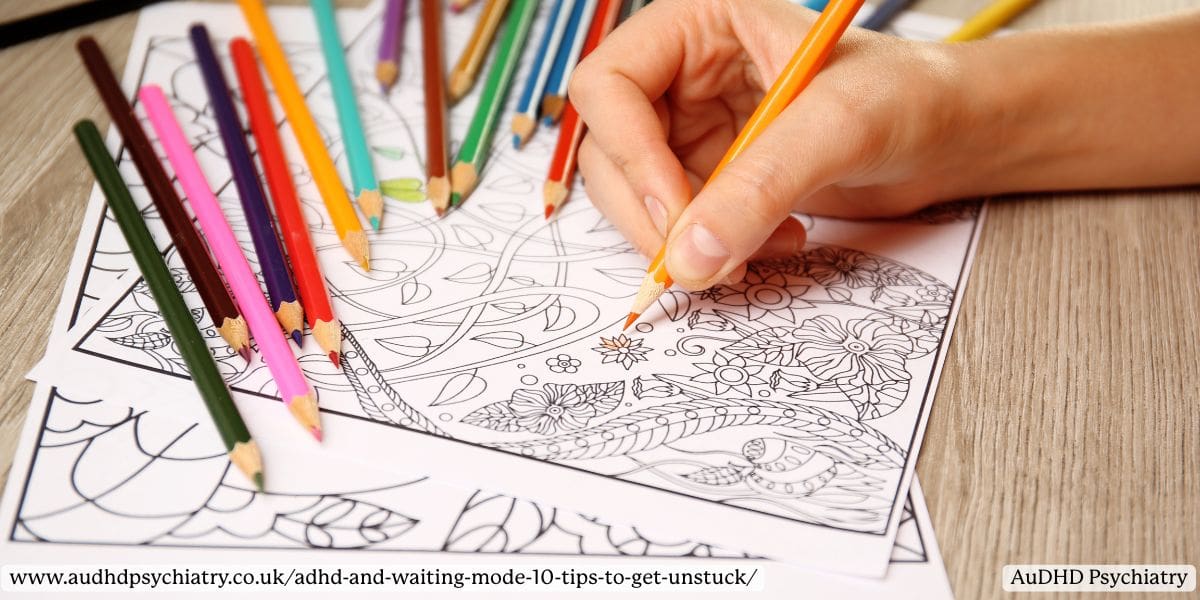
Your Waiting Mode Survival Kit
Create your personal waiting kit – like a Swiss Army knife for your brain:
- Fidget gadgets to keep restless hands busy
- Colouring books or puzzles for the creative mind
- Journals to catch racing thoughts
This kit can be powerful for managing waiting anxiety and ADHD impatience.
Clever Time Tricks for Time Anxiety
Multiple alarms work like friendly time guardians, keeping you on track without clock-watching. Tense muscles? Progressive relaxation techniques help melt that waiting mode tension away, addressing both time anxiety, ADHD and physical symptoms.
Question Your Patterns
Notice what happens when waiting mode strikes. Do your current tricks help or hinder? Practice guessing how long tasks take – our time-blind brains need the exercise. This self-awareness can help improve time estimation skills.
Side Quests and Movement Magic
Keep a list of tiny, pressure-free projects – perfect for waiting periods. Think of them as side quests in your daily adventure. Remember: a quick stretch or walk helps shake off that restless energy, combating task paralysis and ADHD feeling trapped.
Waiting mode mixes executive dysfunction, anxiety, and time blindness into one tricky cocktail. But with these brain-friendly strategies in your pocket, you’ll handle waiting periods like a pro, addressing various productivity challenges along the way.
Smart Reminders That Actually Work when stuck in waiting mode
Your brain handles time and attention uniquely. A smartwatch reminder system boosted attention span by 25 minutes and improved focus by 19% over three weeks, helping to combat task inertia and improve attention regulation.
Task Systems for Waiting Mode Time Management
Time blindness makes task tracking tricky, especially during waiting mode. The solution? Break activities into bite-sized pieces. Try this alarm sequence:
- One for preparation
- Another for departure
- Final reminder for the appointment itself
This system can help manage scheduling challenges and reduce waiting anxiety.
Smart reminders need your active participation. Research shows alarms work better when you must complete specific actions to turn them off. Location-based reminders help too, matching tasks to specific places, which can be particularly useful for those struggling with ADHD can’t do anything.
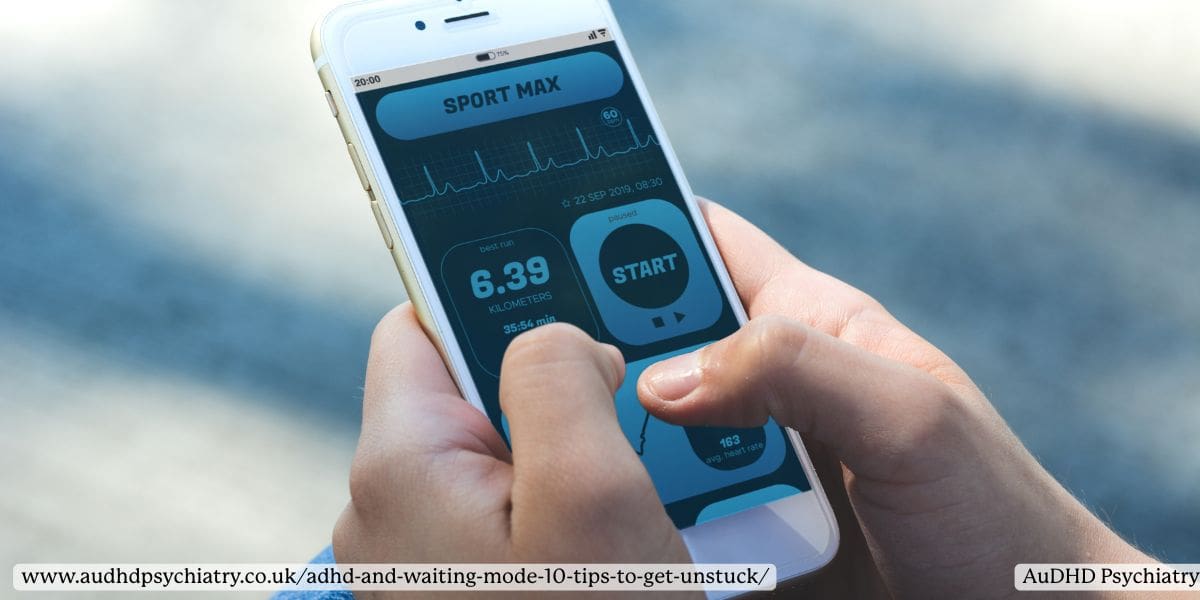
ADHD-Friendly Tech Tools to handle waiting mode
If you’re wondering, “Are there any apps or tools that can help with ADHD waiting mode?” Several apps and tools can assist with managing waiting mode, such as task management apps with visual timers, reminder systems, and AI-powered tools that break tasks into manageable chunks. These help address productivity challenges and attention regulation issues.
Today’s apps pack clever features for managing waiting time. Remember the Milk syncs tasks across all your devices, while Due keeps reminding you until you complete tasks. Fancy scheduling made simple? Try Brili’s drag-and-drop templates. These tools can help address productivity challenges and transition difficulties.
Science-backed features that work:
- Automatic syncing everywhere
- Visual timers for time blindness
- Achievement tracking for motivation boosts
Smart calendars make a huge difference. Next Meeting shows countdown timers, while Sleep Cycle wakes you at the right moment in your sleep cycle, helping to manage time anxiety ADHD.
Virtual body doubling apps keep you company while working. AI tools help split big tasks into smaller ones. Clever wearables watch your attention patterns and nudge you gently when needed, addressing issues of task paralysis and attention regulation.
Watch out though – too many digital reminders can backfire. Physical reminders work well for simple stuff but place them carefully. The golden rule? Reminders should spark action, not just thoughts, helping you overcome the feeling of being stuck doing nothing.
How can I explain ADHD waiting mode to others?
If you would like to help those around you understand what you’ve learned from this guide, here’s how you might approach it: explain that ADHD waiting mode is a common experience for those with ADHD, where the anticipation of an upcoming event makes it challenging to focus on other tasks.
Describe it as a coping mechanism for time blindness and anxiety about being late or forgetting important events. Emphasise that it’s not laziness, but rather a neurological difference in how time and tasks are perceived and managed, often resulting in feelings of being trapped or experiencing ADHD paralysis.
The Waiting Game: Final Thoughts
Waiting mode feels different with ADHD – and now we know why. Our brains dance to their own rhythm when processing time and anticipation. Yes, waiting mode affects how we work and focus, but clever strategies help tame this challenge, addressing issues like ADHD impatience and waiting anxiety.
Think of brain dumps as your mental decluttering service, while strategic alarms act as friendly guides throughout your day. Time blindness and anxiety lose their grip when we stop fighting our natural patterns and start working alongside them, helping to manage time anxiety ADHD.
Science confirms what many of us already knew – waiting mode stems from genuine brain differences, not character flaws. Our unique brain wiring simply needs its own special toolbox. Task systems and consistent strategies turn waiting periods from frozen moments into productive possibilities, combating feelings of being trapped or stuck doing nothing.
Ready to master your waiting mode? Understanding these mechanisms opens doors to better solutions. Curious about your unique ADHD experience? Book an ADHD assessment for personalised insights and strategies.
Remember this: waiting mode doesn’t control your story – it’s just one chapter in how your remarkable brain works. That means with the right tools, you can overcome task paralysis and thrive.
Author:

Dr Darren O’Reilly
DPsych, CPsychol, HCPC Registered, Consultant Psychologist
Connect with me
Ready to take the next step?
Book your ADHD assessment today and get clarity with support that understands you.
